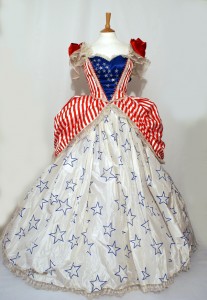Dear CFDA, Michelle Obama’s Wardrobe Should Not Be Political
Sigh. Another day, another critique of Michelle Obama’s choice of an Alexander McQueen dress for the China state dinner.
While recuperating from a skiing accident, CFDA president Diane von Furstenberg took the time to support Oscar de la Renta’s criticism of the First Lady with the following statement:
“CFDA believes in promoting American fashion. Our First Lady Michelle Obama has been wonderful at promoting our designers, so we were surprised and a little disappointed not to be represented for this major state dinner.”
Executive director Stephen Kolb adds “For a lot of designers, their ability to grow their businesses is going to be in the global marketplace. In some instances, there’s really no growth in the U.S. and [these designers] need to do that to succeed. That’s important to us. So anytime that there’s a stage or international setting that you can celebrate American fashion, it’s a good thing.” {the Cut/NY Mag}
Frankly, we’re surprised and a little disappointed that the CFDA and de la Renta are trying to position one dress, at one event as some sign that Michelle Obama is no longer a representation of American fashion, or has somehow crushed an American designer’s chances at succeeding outside of the country.
It’s been a while since any First Lady’s wardrobe has generated this much interest, so to some extent, we get the fuss. On the other hand, Mrs. Obama has – as the statement acknowledges, promoted American designers both emerging and established on numerous occasions. That includes her husband’s inauguration (Isabel Toledo during the day, Jason Wu in the evening), television appearances (Donna Ricco’s $148 black and white dress on an appearance on The View) and yes, even at state dinners (Naeem Kahn, Peter Soronen).
Plus, as the CFDA is surely aware, American design does not equal American made. In fact, browsing through a few garments by de la Renta, roughly half are made in Italy. A large number of von Furstenberg’s clothing is made in China. The New York garment district has gone from riches to rags, in part because the less glamorous, not as creative manufacturing jobs that once made American fashion a complete ecosystem have all but disappeared.
One of the more recent CFDA/Vogue Fashion Fund winners is Sophie Theallet, who lives and works in Brooklyn, but is from France.
CFDA member Marc Jacobs leads design for his own label, but also for a little French brand called Louis Vuitton.
At the worst, if this dress has as much power as everyone ascribes to it, it may encourage a European brand to focus on the United States as a market; the US, where Americans will likely staff stores and back offices. Maybe those people aren’t fashiony enough, but instead of politicizing the choice of a dress, why don’t we discuss ways to revive the image of the US as a fashion design and production country. China’s done it on the offer of being cheaper, Italy’s maintained their place on the offer of being highest quality. Meanwhile, the US scolds an adult woman who had the audacity to wear something she liked. Yes, that’s the problem with the American fashion industry.
Our point is that while yes, an American designer would surely love some portion of the $2.7 billion in publicity the First Lady’s fashion choices generate {the Cut}, American fashion isn’t totally American, and hasn’t been in some time. And thank goodness, because if the industry were that protectionist and fearful of celebrating talent beyond its geographic boundaries, a Dominican born gentleman and Belgian woman of Greek and Romanian descent may have never had a place in it.

